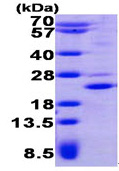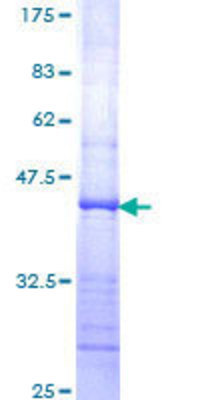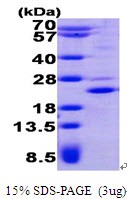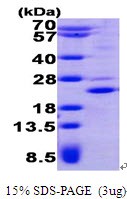PHLDA2
| Gene Symbol | PHLDA2 |
|---|---|
| Entrez Gene | 7262 |
| Alt Symbol | BRW1C, BWR1C, HLDA2, IPL, TSSC3 |
| Species | Human |
| Gene Type | protein-coding |
| Description | pleckstrin homology-like domain, family A, member 2 |
| Other Description | beckwith-Wiedemann syndrome chromosomal region 1 candidate gene C protein|imprinted in placenta and liver protein|p17-BWR1C|p17-Beckwith-Wiedemann region 1 C|p17-Beckwith-Wiedemann region 1C|pleckstrin homology-like domain family A member 2|tumor suppressing subchromosomal transferable fragment cDNA 3|tumor suppressing subtransferable candidate 3|tumor-suppressing STF cDNA 3 protein|tumor-suppressing subchromosomal transferable fragment candidate gene 3 protein|tumor-supressing STF cDNA 3 |
| Swissprots | O00496 Q53GA4 |
| Accessions | EAX02531 Q53GA4 AF001294 AAB86680 AF019953 AAC51912 AF035444 AAC17458 AI659266 AK223027 BAD96747 BC005034 AAH05034 CR407664 CAG28592 HQ448329 ADQ32809 NM_003311 NP_003302 |
| Function | Plays a role in regulating placenta growth. May act via its PH domain that competes with other PH domain-containing proteins, thereby preventing their binding to membrane lipids (By similarity). {ECO:0000250}. |
| Subcellular Location | Cytoplasm {ECO:0000250}. Membrane {ECO:0000250}; Peripheral membrane protein {ECO:0000250}. |
| Tissue Specificity | Expressed in placenta and adult prostate gland. In placenta, it is present in all cells of the villous cytotrophoblast. The protein is absent in cells from hydatidiform moles. Hydatidiform mole is a gestation characterized by abnormal development of both fetus and trophoblast. The majority of hydatidiform moles are associated with an excess of paternal to maternal genomes and are likely to result from the abnormal expression of imprinted genes (at protein level). Expressed at low levels in adult liver and lung, and fetal liver. Expressed in adult brain and neuroblastoma, medullablastoma and glioblastoma cell lines. {ECO:0000269|PubMed:10594239, ECO:0000269|PubMed:10749982, ECO:0000269|PubMed:13129680, ECO:0000269|PubMed:15457853, ECO:0000269|PubMed:9328465}. |
Human TSSC3 full length protein - ab95505 from Abcam
|
||||||||||
Human TSSC3 full length protein - ab173039 from Abcam
|
||||||||||
Human TSSC3 peptide - ab23136 from Abcam
|
||||||||||
PHLDA2 / TSSC3 Antibody Blocking Peptide - LS-E3334 from LifeSpan Bioscience
|
||||||||||
PHLDA2 / TSSC3 Antibody Blocking Peptide - LS-E25645 from LifeSpan Bioscience
|
||||||||||
PHLDA2 / TSSC3 Antibody Blocking Peptide - LS-E21308 from LifeSpan Bioscience
|
||||||||||
PHLDA2 / TSSC3 Antibody Blocking Peptide - LS-E21309 from LifeSpan Bioscience
|
||||||||||
TSSC3 Partial Recombinant Protein - H00007262-Q01 from Novus Biologicals
|
||||||||||
Recombinant Human TSSC3 Protein - NBP1-44473 from Novus Biologicals
|
||||||||||
TSSC3 Recombinant Protein - P3550 from Novus Biologicals
|
||||||||||
PHLDA2-Antibody-C-term-Blocking-Peptide - BP14504b from Abgent, a WuXi AppTec company
|
||||||||||
TSSC3 blocking peptide - GTX25964-PEP from GeneTex
|
||||||||||
PHLDA2 Protein (OPPA01863) - OPPA01863 from Aviva Systems Biology
|
||||||||||
Human PHLDA2 protein - orb163482 from Biorbyt
|
||||||||||
Human Pleckstrin Homology-Like Domain Family Member 2 protein - orb81276 from Biorbyt
|
||||||||||
PHLDA2 Blocking Peptide - 33R-7668 from Fitzgerald
|
||||||||||
PHLDA2 protein (His tag) - 80R-1310 from Fitzgerald
|
||||||||||
Human PHLDA2 Protein - abx068605 from Abbexa
|
||||||||||
TSSC3 Peptide - AC21-0476-P from Abcore
|
||||||||||
PHLDA2 / TSSC3 (1-152, His-tag) - AR09456PU-L from Acris Antibodies
|
||||||||||
PHLDA2 / TSSC3 (1-152, His-tag) - AR09456PU-N from Acris Antibodies
|
||||||||||
PHLDA2 / TSSC3 - H00007262-Q01-10 from Acris Antibodies
|
||||||||||
PHLDA2 / TSSC3 - H00007262-Q01-25 from Acris Antibodies
|
||||||||||
PHLDA2 / TSSC3 - P3550 from Acris Antibodies
|
||||||||||
Pleckstrin homology-like domain family A member 2, Human Recombinant - 228-13224-1 from RayBiotech
|



